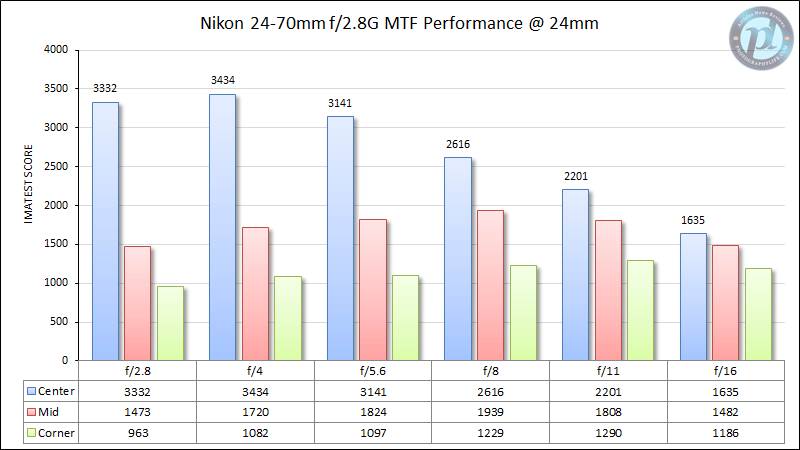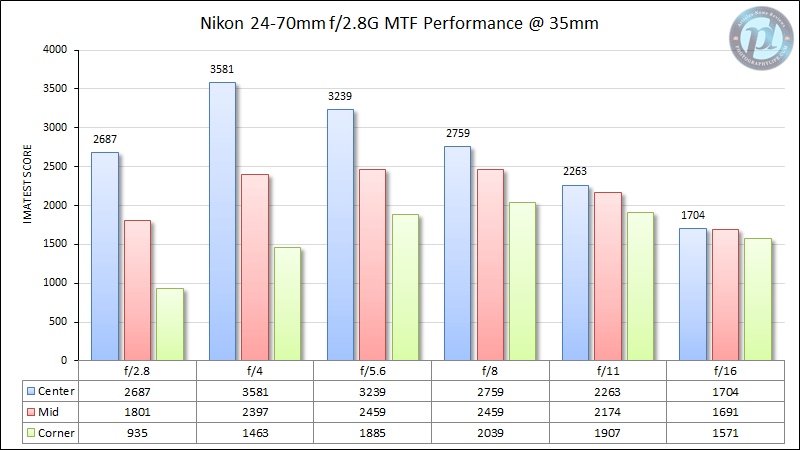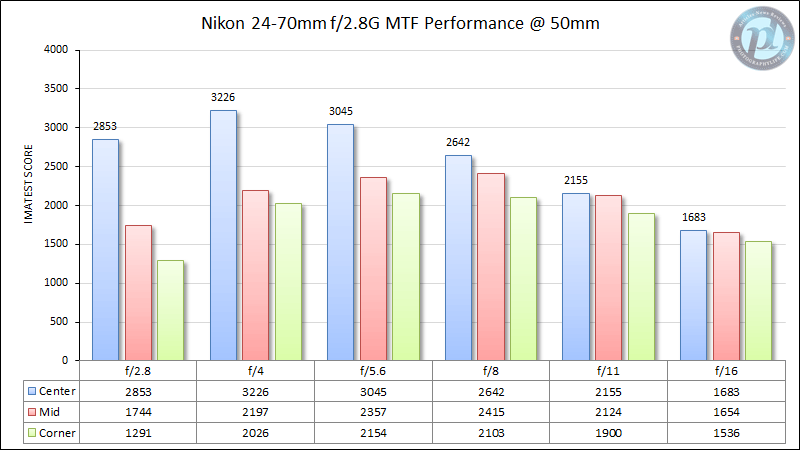Tamron 24-70mm vs Nikon 24-70mm f/2.8G
The Nikon 24-70mm f/2.8G has been my favorite landscape lens for a while now, as noted in my Nikon 24-70mm Review. I love its tough build and super fast AF, both of which have been quite useful when shooting professionally. However, its lack of image stabilization and a number of optical issues have made it tough to keep shooting with it, especially when lenses like Nikon 24-120mm f/4 VR are available today. When Tamron announced this 24-70mm, I really wanted to see how it would compare optically to my Nikon 24-70mm. Let’s take a look.
The Nikon 24-70mm f/2.8G is an extremely sharp lens in the center of the frame, even at the largest apertures. However, its donut-shaped field curvature (quite noticeable on a flat surface) makes it suffer in the mid-frame. It also has rather poor corner performance even when stopped down at 24mm:


As you can see, the Nikon 24-70mm f/2.8G is sharper in the center of the frame at 24mm and a bit weaker in mid-frame and the corners starting out. Once stopped down to f/4 and smaller, the Nikon picks up in the mid-frame and the corners, surpassing the Tamron 24-70mm VC. By f/5.6, both lenses perform very similarly, with the Tamron edging the Nikon out a little outside the center frame.
Let’s take a look at what happens when both lenses are zoomed in to 35mm:


Once again, the Nikon 24-70mm f/2.8G starts out better than the Tamron 24-70mm f/2.8 VC, but this time, we can clearly see that the mid-frame and the corner performance of the Nikon is much better in comparison, especially once stopped down a little.
Now let’s see what happens when we zoom further to the 50mm focal length on both lenses:


Both lenses definitely lose their sharpness at longer focal lengths. The Nikon 24-70mm f/2.8G definitely shines once stopped down, particularly in the corners when compared to the Tamron 24-70mm f/2.8 VC. Stopped down to the f/8 range, both lenses do fairly well, with the edge advantage on behalf of the Nikon.
Lastly, here are both lenses at 70mm:


The Tamron 24-70mm f/2.8 VC produces different results across the frame depending on the target distance. At close distances, it seems to produce more or less even performance from the center to the corners, showing decent numbers. However, at long distances, especially closer to infinity, the lens shows rather poor performance from mid-frame to the edges of the frame (I noticed this behavior on multiple lens samples). As you can see from the above chart, it definitely starts out worse than the Nikon 24-70mm f/2.8 at 70mm, especially in the center and towards the edges of the frame. It regains quite a bit of sharpness when stopped down to f/5.6, but it is still not enough to yield sharp corners. Only at f/8 its corner performance gets marginally better – at the expense of the center frame. You can get sharper center performance by using live view with manual focusing, but the sharper the center, the worse the corners. Field curvature is very strong at the longest focal length on this lens, and sadly, it hurts the lens pretty much at all apertures.
It looks like the Tamron 24-70mm f/2.8 VC is optimized to yield the best performance at shorter focal lengths. Once zoomed in above the 50mm range, its performance decreases sharply, with Nikon 24-70mm f/2.8G producing much more consistent results. The Nikon 24-70mm f/2.8G also produces smoother and more pleasing bokeh and has a little less vignetting problems to deal with. At the same time, the Nikon 24-70mm suffers from heavier distortion issues (stronger barrel distortion at 24mm and pincushion distortion at all other focal lengths), has a little more chromatic aberration issues in the extreme corners and lacks image stabilization. So when choosing between the two lenses, I would recommend to weigh in what is more important for you, keeping the cost difference in mind.
Compared to Nikon 24-85mm f/3.5-4.5G VR
Priced at $669, the new Nikon 24-85mm f/3.5-4.5G VR might seem like a good alternative to the Tamron 24-70mm. It is also a full-frame lens with integrated image stabilization (VR II) technology and it gives slightly more zoom range to work with on the long end. Let’s take a look at how it compares in terms of sharpness on high-resolution cameras like the Nikon D800/D810:


As you can see, the Nikon 24-85mm VR does not stand a chance against the Tamron 24-70mm at 24mm – it has much weaker center, mid-frame and corner resolution across pretty much all apertures.


At 35mm, the Nikon 24-85mm has fairly good center sharpness once stopped down, but it lags behind in mid-frame and corner performance, as shown above.


We see a similar situation at 50mm – the Nikon 24-85mm is still worse overall, especially when stopped down to f/8.


And at 70mm, the Nikon 24-85mm VR yields pretty good center sharpness, but its mid-frame and corner performance still suffer quite a bit at larger apertures. When both lenses are stopped down to f/8, they look pretty close though.
Except for the telephoto range of 70mm, the Nikon 24-85mm VR clearly falls behind the Tamron 24-70mm f/2.8 in terms of resolution. This is especially noticeable in the mid-frame and corners, where the Nikon 24-85mm VR just does not do well, period. In addition, the Nikon 24-85mm has a bunch of other optical issues – it has more vignetting, distortion and chromatic aberration problems, especially at shorter focal lengths. You certainly get what you pay for…
Table of Contents